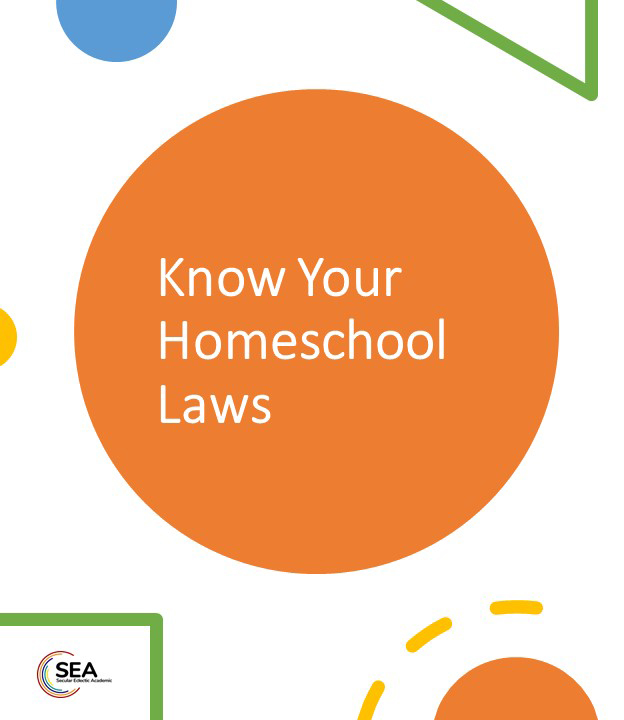How to Homeschool 101
You Have Decided to Homeschool! Now What?
This practical How to Homeschool 101 article gives you the information you need to get started. Includes a free PDF download.
Let me acknowledge the elephant in the room right away: yes, it is a big responsibility to choose to educate your child. You won’t hear that many places in the homeschooling community, and that’s too bad. It makes new homeschoolers feel as if everyone has it figured out but them, when in fact, it’s a learning curve.
Like any new endeavor, it can be challenging to figure out all the pieces and how they fit together. You will have a much clearer idea of the basics after you have some experience. There are pieces that must come together to help you and your children succeed with homeschooling, but the good news is that most of these are simple and straightforward.
How to Homeschool 101: Step 1
Know Your Homeschooling Laws
Before doing anything, make sure you are homeschooling legally. In the United States, homeschool laws vary by state. The best place to find information to ensure that you are complying with the laws in your state is through a state homeschooling organization or your state’s Department of Education. On the SEA Homeschoolers 101 page, you can find links to every state’s laws.
At this initial stage, you will learn if there is paperwork you need to file, a date to register by, the compulsory school age, and/or if there are attendance requirements. You will want to know if your state has a portfolio requirement for homeschoolers, and if they do, what it looks like in your state.
Some states have testing requirements and restrictions on who can administer them. In addition, some states have restrictions on the curriculum you can use. There are also states where evaluations must be completed by a person on their approved list of evaluators.
If you think your child needs an IEP or accommodations, it is important to investigate how that works in your state. Learn the process for getting these for homeschooled students in your state.. Find out what services are provided for homeschooled learners with an IEP. In some states, no services are available.
After you have discovered your state’s requirements, members of the SEA Homeschoolers Facebook group who live in your state are a great resource for any questions you may have. For example, California does have a deadline by which you must register, however, there are no penalties for filling the form out after the date. As a resident of California who homeschooled her son, I am able to offer that information to members of the SEA Homeschoolers Facebook group! We are a diverse group with members all across the country, and all members can benefit from that base of knowledge and experience.


What will you do with your one wild and precious life?
How to Homeschool 101: Step 2
Dare to Dream
At its best, a homeschooled education is a handcrafted education that focuses on the unique strengths, challenges, and passions of the individual. It gives students an education that honors who they are as a learner and how their unique brain works. The benefits of homeschooling in this way are profound, empowering, and the best path for helping your child gain the tools they need to get to do what they want with their one wild and precious life.
Take some time early on to answer the following questions. When you think about your child as a learner, what do you want for your child? What do you hope is the end result that comes from homeschooling? What does the ideal learning journey look like for you?
Stephen Covey, the author of The Seven Habits of Highly Successful People has as his second habit – Begin with the End in Mind. According to Covey, all things are created twice – there is the mental creation and the physical creation. Your homeschooling is much more likely to be successful if you write down your dream for your child’s education, crafting a mission statement for homeschooling. This is the mental creation for what homeschooling will mean to your child and your family. Make it big and profound. Ask yourself what your journey will look like. Do not let your nerves or doubts keep you from dreaming big. The journey starts with a direction, then you put one foot in front of the other.
After that, you can work on the physical creation by getting started making the mental creation a reality. Because this journey starts with one step, the beginning is important too. It is a good idea to give some thought about how, on day one, you might actualize your dream.
A learner-centered education like this is a profound gift to give a learner. It might not seem that way every step of your journey, but it will benefit the learner’s relationship with learning overall.
Read The Renaissance of a Handcrafted Education for more on this topic.
How to Homeschool 101: Step 3
How Does Your Child Learn?
Every day, new (and even experienced) homeschoolers enter Facebook groups and ask about curriculum. There is no information offered about how their child learns, and they do not ask the people recommending curriculum about how their children learn, either. One of the most fundamental tenets of homeschooling is that it is an education that focuses on the individual. To provide an individualized education you need to know how your children access and process information. If you use this information when you do ask for information, you will get better answers.
Are you thinking, “I have no idea where to even start figuring this out!?!”
Tip 1: What learning modalities does your child primarily use?
Watch how your child approaches academic endeavors. Focus on the primary modalities your child uses for new or challenging tasks. This gives you important information about how your child instinctively chooses to access and work with information.

Auditory learners learn by listening. Podcasts, webinars, audiobooks, or face-to-face instruction are good paths for them to process and access information. Group discussions or debates can also form part of auditory learning.

Kinesthetic learners process and access information through doing. Good lessons for these learners often a combine other types of learning. For example, when learning a historical event or topic in science hands-on projects with videos or reading will benefit learning for kinesthetic learning.
Visual learners process and access information more effectively when graphs, infographics, cartoons and illustrations, videos, artwork, flowcharts, and diagrams are included in lessons, things that stimulate the learner’s eyes. Making visual observations, such as through drawing, can benefit this cohort of learners.

Reading and writing learners process and access information through text-based courses, PDF’s, documents, books, and eBooks. These learners are often good test takers. We are most familiar with this type of learning primarily because of the systematic teaching of this method in traditional school.
Struggling to find a reading curriculum? Check out this article.

In addition to learning modalities look for:
- Do you have a child that asks lots of questions? I know that sometimes this drives parents and teachers nuts, but ask yourself: is this how your child processes information. Is that how they start to puzzle out the answer? Or maybe your learner doesn’t ask questions. That can be frustrating too. In either of these situations, or if you have someone in the middle, start to think about how your child processes information.
- Does your child learn through collaborative learning or are they a solo learner? these are the extremes. Most people are somewhere in the middle. Where an understanding of this can help you is, for example, if you have a child who learns best in a collaborative setting, you might want to pick a live online class or a co-op for subjects your child finds challenging. That way they will be more engaged as they’re learning. Some students really benefit from learning where there is a discussion component and/or brainstorming.
Or perhaps you have a learner who prefers to learn things on their own. Some learners find collaboration to be a distraction to thinking. With a solo learner you need to pay more attention, in case they need your help to puzzle through things, they might have missed. It’s actually good to be able to work collaboratively and as a solo learner. It helps to scaffold students to work in both situations. However, you have to be careful with this, some kids who are solo learners will turn off in collaborative settings.
- Does your child need a lot of validation about whether they’ve learned something or not. My recommendation is that if your child needs validation, give it. It can be an age or a stage situation. Make sure that your validation is genuine and specific about something that they know.
It can be a situation where a learner is not strong in their metacognitive skills, so they really don’t know what they know. Some people need to know they have learned something, completed one task, to go on to the next.
Tip 2: Learn from Your Prior Teachers
The good news is, you can draw some parallels from how a child’s biological parents learn. Studies have shown there are genetic components to how people access and process information. Be thoughtful, however, if you use this information from how you learn as an adult. It isn’t about how a child’s biological parents learn as adult. What matters is how they learned best as children. As a secondary caution, genetics is complicated, so this tip might or might not be helpful.
Because of the genetic component, it can be helpful to think about teachers you responded too. (This is a good exercise even if you are not the biological parent.) As you are figuring out how your child learns, there is absolutely no reason to reinvent the wheel. Think about the techniques used by your favorite teachers. Could you incorporate those into your homeschool?
What about the techniques used by your least favorite teachers. Let’s just say 3 grade was really bad for me, with a teacher who insisted we all do the same phonics and vocabulary programs at the same pace in class every day, no matter what our reading level. That experience had a big impact on my understanding of the importance of individualized learning.
Check out this article filled with homeschooling advice for a former school teacher.
Tip 3: Methodologies
Educational methodologies are based on educational pedagogy. There are several you hear about in the homeschool community. Several popular homeschool curriculums are based on specific methodologies, and good educational philosophy exists in many of them. It is worth taking the time to read those over with a highlighter in your hand. Do not assume that because a methodology resonates with you, that it will be a good fit for your child. If it appeals to you, it simply means that, as an adult, you could learn from that methodology. The word eclectic in Secular, Eclectic, Academic Homeschoolers refers to using a hodgepodge of these. Eclectic Homeschoolers use whatever works best for the child and the academic subject.
If you are interested to learn how to incorporate travel into your homeschooling, read our worldschooling article.
Tip 4: Learning Skills

- #1. Balanced learners are multimodal learners. As the word suggests, multimodal learners learn using all four modalities. Most people are strong in one or two of these. A multimodal approach incorporates work done using all of these modalities. This enhances the likelihood that a learner will be a balanced learner, able to access materials using the best modality for the job, instead of a heavy reliance on one or two modes. Balanced learners are strong enough using each of the four modalities to choose the one best suited to the learning task.
- #2. Metacognition is the ability of a student to know what they know and how to retrieve it for use in all settings. With a metacognitive approach, students use prior knowledge to organize, monitor, and adapt the way you approach new learning material and situations.
- #3. Too often executive functioning skills are worked on outside of academic settings. That’s too bad, because executive functioning skills are often the easiest way to work on as a part of learning. Executive functioning skills are also critically important for academic success. I was a college professor before homeschooling my son, and there are numerous instances that I can think of where students struggled in my classes because they didn’t have the executive functioning skills needed to pass college science class.
How to Homeschool 101: Step 4
Choosing Curricula
For most home schoolers choosing curriculum is one of the most fun parts of home schooling and one of the most frustrating. The good news is there are so many options you can find something that is a good fit for almost any learner. The bad news is there are so many options you can lose whole years of your life while searching for just the right curricula and programs. I have a few tips to help.
- #1. It should come as no surprise that curricula that have been around for a while have more reviews than those that are new. In addition to general reviews, since more people have used the materials, it is easier to find people whose children have a similar learning style to yours who were either successful or unsuccessful using the materials. If user reviews are a major criterion that you use, then you are likely going to prefer time tested materials. There are established publishers who are known for the quality of their materials, and my experience in the home school community is that you can assume that new materials from them will be consistent. The shiny new curriculum that no one has ever heard of, however, you probably want to ask about it in a an online group.
- #2. Using what you have learned about how your child learns helps immensely when choosing materials and will likely save you money.
- #3. If you want to work on learning skills, and you don’t want to do all the planning of how to integrate those on your own, look for curricula and program that incorporate them into their materials. If it’s not obvious to you how this is done, reach out to the publisher or author and ask if they do this and state that you would like some concrete examples of where it’s done in the materials.
- #4. It is hard to know what delivery of materials will work best for your child when you start out. Some learners thrive online, others need printed course materials. Some homeschoolers prefer handcrafting a year where they choose the subjects, others prefer an all-in-one curriculum. There is no right or wrong, it’s simply what works best for your child and your family situation.
- #5. Even though you are just starting out, it’s a good idea to discuss the pluses and perils of switching mid-year. If your child is struggling with a subject your first thought might be that it’s the curricula. Before deciding that you’re going to switch, take the time to diagnose to make sure that’s the issue. Good curriculum has a comprehensive structure where topical information builds on itself. If you switch, you can create a situation where your child does not get a comprehensive year of learning in that subject.
- #6. Curricula and programs take time and money to develop. It has to be sustainable for the writers and publishers to put in their time. If you have a budget, it can be helpful to do your planning ahead of time. Budget for the materials, and ask online about when companies have sales.
- #7. It’s homeschooling, which means you can write or piece together your own materials. This is how I came to write my first course, R.E.A.L. Science Odyssey Chemistry 1. I could not find a secular chemistry course for my son when he was going into third grade. I did not start out with a yearlong course, and I don’t recommend you do that either. A unit study is a good place to start. BY starting smaller you can become more skilled as you go along. I wrote this article, How to Handcraft a Unit Study, to walk you step-by-step through the process of how to do that.

How to Homeschool 101: Step 5
Get Organized
I hear some of you groaning, but…
Effective organizational strategies in homeschooling helps create a structured
- You annual academic schedule is totally up to you. You should use whatever works best. A lot of homeschoolers, even if it is not what they plan, end up doing year-round. OA major benefit of homeschooling, is the flexibility around scheduling. However, if your child takes online classes, there will usually be a start and end date.
- Do yourself a favor right from the start, organize your homeschooling resources, such as books, educational materials, and online subscriptions. Even over the course of a year, you can amass so much!
- Implement a system to track and monitor your child’s progress. You do not need to keep everything, but you should keep work samples. This can include maintaining records of completed assignments, assessments, grades, and any other relevant information. Organizing these records helps in evaluating your child’s development and providing necessary feedback. Staying up on this can save headaches if you ever need their school records.
- Establishing a daily or weekly routine provides a predictable schedule for both students and parents. Establishing set times for different subjects, breaks, and activities helps create a sense of order and consistency in the homeschooling routine. Some students need a routine to thrive.
- The number of learners you are homeschooling requires different organizational strategies. For multiples, the more organized you are the easier it is to homeschool. Combine if you can. If you are thinking the age range is too great, or the kids fight like crazy, you can give different assignments. So, on the teaching end it looks the same topic but on the student end they are working on different assignments. For an only, some organization that includes collaborative learning can be important. This often means you are their co-collaborator.
- Do you like to plan? I do! While organization is important, remember to be flexible and adaptable in your homeschooling approach. Allow room for spontaneous learning opportunities and adjustments as needed. Organization should support your homeschool journey, not limit it. One thing that can be stressful for people who like plans is when, for example, an assignment you schedule for 10 days takes 5 or not 5 but 15. If it takes 10 – perfect planning – if it takes more or less – the plan wasn’t perfect – it is not a reflection of the learner. And if it is important to learn, it takes the time it takes for your unique individual. For example, if your child takes two years to learn multiplication tables and you planned for one year, they took two years. The plan was the problem.

How to Homeschool 101: Step 6
My Final Tips
- Socialization: Socialization is finally easier again, especially in states that have large secular groups. Unfortunately, it is still a struggle for those who do not. If you’re struggling to find a group where your child can socialize, get into the SEA homeschoolers Facebook group and look for people in your area. The good news is through the Outschool platform, if you’re struggling to find local socialization for your child there are online socialization clubs.
- You have to be careful when you’re homeschooling that it isn’t school all the time. You are thinking about your child’s education a lot. It is easy to get stuck in school mode.
One thing that can be kind of tricky when you are both a teacher and a parent is discipline around academics. It will likely happen that you need to discipline your child around an academic issue. It can be so easy to let things slide that you would never let slide if your child did it to a teacher who wasn’t you. It’s good to have a plan, how you’re going to handle it if that happens.
- Be kind to yourself as you learn your new job. Give yourself the same space and respect that you would give others who were trying to gift their child with an education that honors who they are. It is important to have expectations that are reasonable based on where you are at.
Do not expect yourself to be perfect. I am not a big fan of that word. I believe that perfect is an opinion word. If you are a person who thrives on perfection, every day that you show up for your children and do your best I will define that as perfect for you.
As a side note, if you are a person who expects yourself to show up and be perfect right away, that is something that you want to be very careful of as you homeschool your children. We are models for our children about normative behavior. It’s important that we talk to ourselves and about ourselves in a way that models how we hope our children talk to themselves and about themselves.
- I urge you to find a support community. You need a group of people, even if it is online, to support you on this journey.
Welcome to Homeschooling, Blair Lee & the Entire Team at SEA Homeschooling

Free How to Homeschool 101 PDF workbook to help you get started.
Join Host Blair Lee for SEA Homeschoolers Book Club. Each month we will read a book focused on helping us teach our kids.
Want to know what SEA Homeschoolers is about? The SEA Homeschoolers Team collaborated on a list of 27 WE BELIEVE statements so you would know the answer!
This is part of The Learner’s Toolbox from Blair Lee. The Learner’s Toolbox is a multi-part series in the SEA Homeschoolers Magazine and SEA Homeschoolers Online Conference Series that focuses on learning skills that are essential for lifelong learners.

